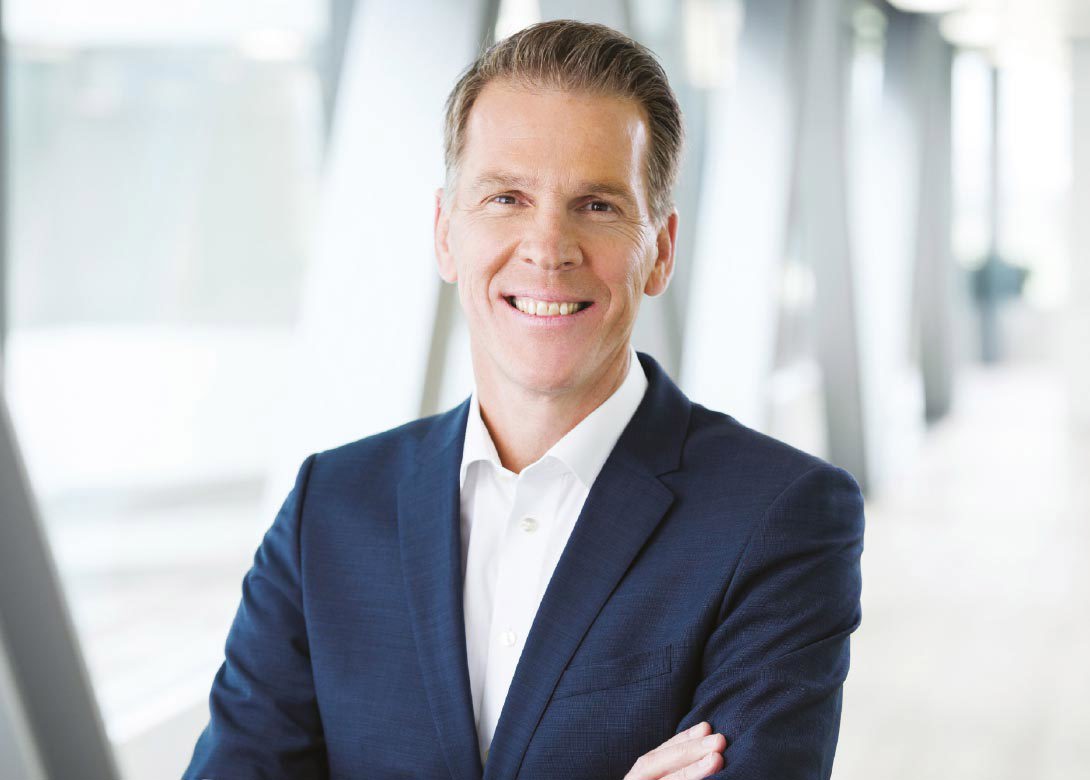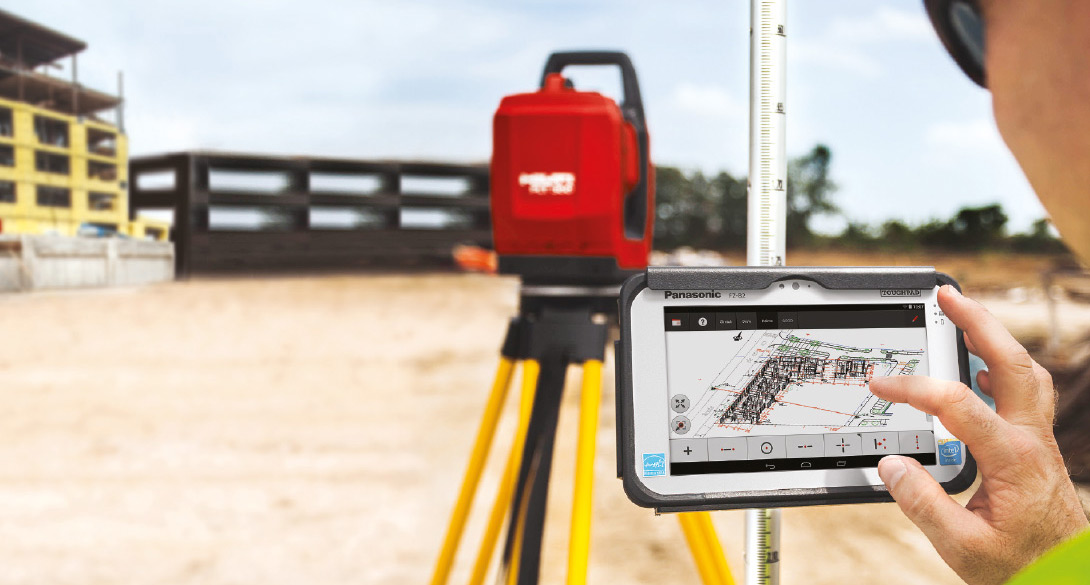
Executive Editor Phil Matten met with Stefan Nöken at Hilti’s corporate headquarters in Schaan, Liechtenstein. The conversation was wide-ranging but the most thought-provoking element was an incisive vision of how digitalisation of the construction process will affect all its stakeholders in the coming decade.
“I don’t talk about Construction 4.0 – I really don’t like this expression,” says Stefan Nöken, robbing the objection of any rancour with a smile. “Construction 3.0, 2.0 didn’t happen, from my point of view, so we are still at Construction 1.0.” Previously the conversation had touched on Hilti’s growth in the energy and industry sectors, where there is a distinct ‘front-loading’ of the customer relationship – exactly, says Nöken, as happened in the automotive and aerospace supply chains decades previously. “Get it right at the beginning of the project and in the first 20% of the cycle time 80% of the costs are already defined.”
That early relationship is equally important to the future of the core construction business, which still accounts for 85% of Hilti’s global revenues – a logical enhancement, indeed, of the direct sales and supply model that has differentiated Hilti for most of its 75 year history.
“We now have almost one thousand engineers around the globe. These teams go to our customers – but not just to the job site managers. They mainly go to the design offices, the architects, to owners – to help with the front-loaded engineering. It has come later to the construction industry but it is happening now, because the technologies available are much more appropriate to construction.”
For Stefan Nöken the critical catalyst for change is productivity. “The construction industry is the only one that has made no real progress in this regard over the last decades.”
“These latest technologies provide a huge opportunity to bring productivity to the construction industry. Some means were there in the past but now they are much more comprehensive, much easier to use, much more mature. We are talking about the real digitalisation of construction, and more specifically about building life cycle management.”
The key development is Building Information Modelling (BIM), which “allows, for the first time, a full digital representation of the building, in all geometrical, physical, time and cost dimensions”. Previously the construction industry relied on “a rough understanding of the building – sketches without the detail to manage a seamless construction process”. There were many grey areas, adds Stefan Nöken. “That meant many decisions had to be made ad hoc on-site.”

The result, he argues, was solving issues late in the process, resulting in cost and time overruns and potential quality and safety issues. It meant a “quite chaotic working environment” with limited co-ordination and multiple stakeholders pursuing their own priorities. Each building was “one of a kind with very little scaling and few replicates”.
“This all comes because the design did not have the necessary detail. There was an understanding of the outer shape; an understanding maybe of the major geometrical dimensions but not, just as one example, how the heating and ventilation should work with the electrical installation. That meant a work package for the HVAC contractor; another for the electrical contractor; and they met for the first time on the job site. Whichever was first, installed their way – and the second had a problem!”
“Now contrast, if I have a full representation of the building, I understand all the conflicts and they are resolved between all stakeholders, on a planned basis. That maturity, the detailed planning prior to execution provides huge advantages and delivers real productivity gains. The process is faster, fewer last minute changes, so money is saved and the solution is of a higher quality.”
“So if you ask about the job site of the future, I see the need for a full digital representation of the building at a real level of detail that makes the execution of the work easy and flawless.”
That is far, however, from Nöken’s complete vision. “The second thing is building life cycle management. You have the benefit of all the information for the construction phase, to allow time planning, material planning and cost planning. However, with the life cycle of a building maybe fifty years, most costs are actually incurred during the usage, not building, phase – just think about energy consumption as one example. Building life cycle management means three phases, the design, the build, but also the operation – and it is the latter that has been neglected.”
Using BIM to maintain a building over its lifetime makes impeccable sense to Stefan Nöken and he sees it of critical interest to the owners of the building. “Look at fire safety inspection. You need to know who did the installation, as well as the specifications of the installation and materials. Then how helpful is it to also know what the building has experienced in the last five years, temperature ranges, perhaps ground tremors, where the main traffic is – overall, what condition is the building in today?”
Stefan Nöken recognises that structural monitoring has been around for some time but he envisages a holistic monitoring system collecting comprehensive data, in order to optimise the usage of the building. “You can install sensors in the lighting system that monitor usage of each part of the building. Today’s technology can process that ‘big data’ and identify potentials for greater efficiency, increased utilisation, reduced costs, improved return on investment.”
The adoption of BIM and building life cycle management varies tremendously by geography, Stefan Nöken acknowledges. “It is happening more in Europe and North America than the emerging world at present. Within Europe it is happening more in the north than in the south. It is also happening in the bigger, and more complex projects, because here the benefits are more substantial.”
Critically, he adds: “It is happening specifically in buildings where the design, build and operation is one hand – where the owner has an interest.” That contrasts with the classical developer model, where the land is bought, a multi occupational building constructed, and it is sold off. “So the constructor thinks, not my concern any more, why should I collaborate in life cycle management?”
“The owner is the key driving force. That is why we see companies that own very investment-intense facilities – data centres, production facilities, pharmaceutical plants, big hospitals – really interested. Also where governments are the owners; infrastructure in Germany, public projects in the UK.”
“The second driving force is the general contractor. They also suffer because they make the offer to build the building, then all the different trades are brought in. Organising on the job site is time consuming and costly: Far more intelligent to do it all up front.” It is worth recognising, however, that the sub-contractor, who “often earns a lot of money from change management”, does not necessarily share the same incentives.
The vision, then, is clear. What, though, are the implications for the supply chain – and for Hilti specifically?
“For Hilti, we start with the design phase, where it has a lot to do with engineering software solutions. We provide the software that means the structural engineer no longer has to look up in his book, do the calculations and work it out fastening point by fastening point. Our engineering design solution has interoperability with the structural design software. It takes the 3D geometry, carries out the calculation, and feeds back the information to the structural design software. Customers love us for that because it is a fast, easy and straight forward process.” It also satisfies two key concerns: Safety and the assurance the final design will be robust for fifty years, and productivity – a rapid solution that covers not just fastenings but fire protection or installation solutions.
Next is the provision of a full digital catalogue of Hilti products. “It is not enough just to be able to pick a ‘stupid’ geometric representation. It must be intelligent, linked to the approvals and technical specifications, and cost information, so the initial cost estimate for the building can be reliably generated from the BIM.”
Hilti also offers some clever automation tools. Fire protection is a good example. For a large building this is a very time-consuming process, going room to room, and thinking about every wall penetration. Hilti software identifies the fire rating of the wall and the wall penetration dimensions, and proposes the proper solution to meet the fire rating – which can then be replicated for all similar wall penetrations in the building.
After engineering solutions, the product library, and automation tools, comes the challenge of translating the complex design to the practical job site environment. “For BIM to field, our Total Stations technology is invaluable. The 3D model is translated to mechanical or robotic measurement and location equipment – eliminating complexity, delivering productivity but also ensuring accuracy.”
The second job site solution is tool management. Hilti tools have embedded software, which monitors performance and provides utilisation data, the basis for identifying opportunities for improved productivity and managing preventative maintenance. Planned servicing eliminates the costly downtime related to ‘crisis’ repair.

“Even more attractive for our customers,” says Stefan Nöken, “is Hilti’s ON!Track solution for managing the entire assets on the job site”. Bluetooth technology connects each tool’s data readout to a personal device, so the manager on-site can immediately see all the assets on-site and how they are being utilised. Higher cost, lower usage tools can be shared across several sites but remain immediately locatable when required. “ON!Track also connects with the customer’s ERP system for billing, so they know how long an asset has been on-site and account for it accordingly.”

“Many sites still try to manage all of this by spreadsheets. There are other solutions around now, but none match the state of art Hilti solution. The key differentiator is that all our solutions
are integrated.”
In Europe more than 50% of Hilti tools are now fleet managed – in some countries the figure is nearer 75%. “The logic is compelling,” says Stefan Nöken. “You have a trouble-free, low concern solution that assures tool availability. Fleet management also incorporates a tool exchange service, which means continuous productivity, as opposed to down time for repair – even with Hilti’s superfast response, that can still mean three days without the tool.”
The last element is maintaining the building and here Hilti focuses on critical documentation. “In Europe today we provide a documentation manager, which is really working nicely. As soon as fire protection is installed a barcode is scanned and linked to a cloud-based solution that can document the entire building. A virtual representation allows the owner to see exactly how the fire safety solution looks – not just for Hilti products but also sprinkler systems and everything else. The result is complete transparency on the fire safety installation for the building, including advance information of and for the next inspection.”
Answering a question earlier in the conversation about Hilti’s overall Champion 2020 corporate strategy, Stefan Nöken said: “Hilti aims to achieve sustainable value creation through leadership and differentiation. Market leadership through added value for our customers –
by offering products, services and software that provide superior productivity and safety to our customers – and differentiate from the offering of our competitors through innovation. We have to have the uncontested leading offer from a customer perspective – we have to be considered the partner of choice. Only if we achieve that will customers give us their business. Our value proposition has to be compelling.”
He could have added clear-sighted vision – but, as this conversation demonstrated, that really isn’t in doubt.
About Dr Stefan Nöken
Stefan Nöken has been a member of the Hilti executive board since the beginning of 2007 and is responsible for fastening technology and logistics. Born in 1965, he joined Hilti in 2000 as the head of corporate engineering. In 2004, he took over responsibility for supply chain management with the global plants, procurement and global logistics.

Having held senior management roles in leading automotive and fastener businesses, Phil joined Fastener + Fixing Magazine as editor in 2002. Convinced there is no substitute for ‘being there’, over 17 years of visits and interviews around the world means he has accumulated an extraordinary knowledge and perspective of the global fastener industry, reflected in his incisive and thought provoking reporting.
Don't have an account? Sign Up
Signing up to Fastener + Fixing Magazine enables you to manage your account details.